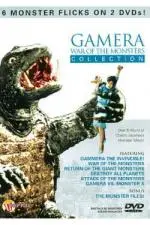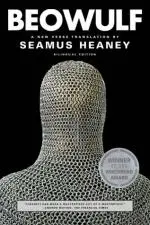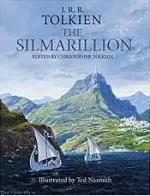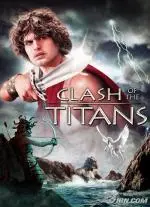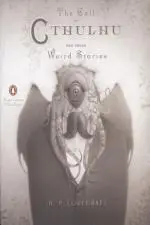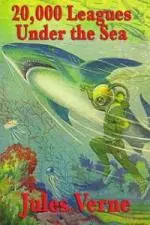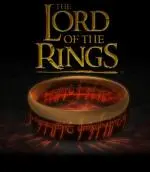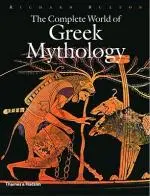Monsters.
They’re one of the greatest parts of Fantasy, one of the features of the genre. Monsters are, simply put, freaking cool. Anyone who ever cracked open a Monster Manual (or perhaps the Fiend Folio) and flipped through its pages knows what I mean. The best monsters are powerful, scary, and just plain weird.
I consider author China Mieville to be the patron saint of monsters. For example, you can read him talking about them here, and here, and here, and here. Because he says it better than me, I’m not going to go too deeply into what makes monsters great. I will, however, pick out two of his points: that monsters should always be somewhat unknowable, and that sometimes a monster can be just that: a monster.
This month sees the release of Pacific Rim, where men in giant robot suits fight the giant monsters that threaten their world. And so it seemed like a good time to look at some of the best monsters from myth and fantasy fiction. Since Pacific Rim deals with giant monsters, I’ll be focusing on them in this post, though I reserve the right to return to smaller monsters in a future column.
This column is dedicated to Ray Harryhausen.
![]() 1. Gamera (Kaiju films)
1. Gamera (Kaiju films)
The Japanese kaiju are probably the giant monsters that most people think of, Godzilla being the most popular. And don’t get me wrong, Godzilla is pretty cool, but my favorite was always Gamera. Reptilian, like Godzilla, Gamera takes the form of a giant turtle that can walk on two legs. Unlike most turtles, Gamera has teeth and two large tusks in his mouth. He can also breathe fire.
Unlike Godzilla, Gamera can fly, retracting his head and legs into his shell and spinning around through the air, flames bursting from the holes containing his limbs. His shell is incredibly hard, resisting most attacks.
In many of the kaiju films, Gamera fights other monsters, but as is typical for such films, the collateral damage can be great, destroying buildings and harming innocent bystanders. Like many great monsters, Gamera’s motivations are opaque to us mere mortals.
[amazon B0088FS27C inline]
![]() 2. Grendel (Beowulf)
2. Grendel (Beowulf)
Beowulf faces three enemies—Grendel, Grendel’s Mother, and a dragon. But since there’s ambiguity on what exactly Grendel’s mother is, and because dragons are covered separately (see below), I’ll focus instead on Grendel himself. There’s not much said about Grendel’s appearance beyond the fact that he’s “very terrible to look upon.” Many translations, however, treat him as monstrous, and larger than normal. To add to his villainous nature, Grendel is said to descend from Cain, the first murderer. Grendel attacks Heorot, the great hall of King Hroðgar, and kills (and eats) many of Hroðgar’s men, driving the rest away.
Of course Beowulf being the hero, he must overcome his monsters. Beowulf goes to Heorot with his men and prepares to face Grendel. Because Grendel isn’t armed, neither is Beowulf, though Grendel’s skin seems to resist the other warriors’ blades. In the end, Beowulf tears the arm from Grendel’s body and the monster retreats to die.
[amazon 0393320979 inline]
![]() 3. Dragons (Various)
3. Dragons (Various)
I knew I needed to have a dragon on this list, though it was hard to pick just one. One of the most famous is, of course, Smaug from The Hobbit, though in Tolkien’s world Smaug is the last of the dragons. Glaurung was the first, the Father of Dragons, described in The Silmarillion. Glaurung breathed fire, though he didn’t have wings, and he could control Men with his mind. Ancalagon was the first winged dragon, bred by Melkor (later Morgoth), the original evil in Tolkien’s universe. He was said to be the largest of the dragons and his wings could blot out the light of the sun. It took Earendil and his allies to destroy him.
But Tolkien doesn’t have a monopoly on dragons. Dragons are a staple of the fantasy genre, and while they aren’t always monsters, that seems to be the prevailing version of the creature, whether intelligent or not. From St. George and the Dragon to Beowulf to Michael Carpenter in the Dresden Files, dragons are often THE monsters that must be overcome by the hero of the tale.
While we’re talking about uber-dragons, though, I have to give mention to Tiamat, the dragon goddess from Dungeons & Dragons. Tiamat is not one dragon, but five, or rather one dragon with five heads (white, green, blue, black and red). Pretty monstrous.
[amazon 0618391118 inline]
![]() 4. The Kraken (Clash of the Titans)
4. The Kraken (Clash of the Titans)
Ray Harryhausen created many monsters, from skeletons and ghouls to cyclopes, a hydra, and Medusa herself. And if we’re looking at large monsters, in addition to the Cyclops there’s Talos from Jason and the Argonauts, an immense statue that threatens the crew of the Argo. But if we’re going to pick one giant Harryhausen monster, in my opinion it must be the Kraken.
Let’s look past the fact that the Kraken of Clash of the Titans is nothing like any kraken that bore the name before it (typically monstrous giant squids). It’s still quite a monster. In the original film the Kraken was a Titan, the last in fact, used by the gods to bring retribution on cities they wanted to punish. Zeus uses it in the beginning to destroy Argos, and it’s later used to threaten Andromeda for crimes against Thetis. The film’s most famous line is, of course, “Release the Kraken.”
The Kraken was brought to life by genius visual effects artist Ray Harryhausen. Drawing from myth, it is a giant sea monster, but humanoid, scaled and with four arms. Its lowed half is part reptile, part fishtail, and it is capable of destroying whole cities and injuring innocent bystanders. Only the head of Medusa (another fearsome monster, though not quite giant) stops it by turning the Kraken to stone. And Perseus only learns this by undertaking a quest and tricking the Graeae (called the Stygian Witches in the movie).
[amazon B002ZD3V10 inline]
![]() 5. Cthulhu (H. P. Lovecraft’s Mythos)
5. Cthulhu (H. P. Lovecraft’s Mythos)
H.P. Lovecraft created many monsters, most of them horrors that the human mind couldn’t comprehend, but the most well-known of these is certainly Cthulhu. In fact, the cycle of stories that Lovecraft and others contributed to was labeled the Cthulhu Mythos. Cthulhu’s appearance blends humanoid, octopoid, and draconic features, the latter two elements recurring on this list. He is also hundreds of meters tall.
Cthulhu first appears in the story, “The Call of Cthulhu,” slumbering deep beneath the ocean in the city of R'lyeh. While in hibernation his mere presence causes anxiety for people, felt subconsciously. When Gustaf Johansen and his crew find R’lyeh, they open a portal, releasing Cthulhu at last:
It lumbered slobberingly into sight and gropingly squeezed Its gelatinous green immensity through the black doorway into the tainted outside air of that poison city of madness. … The Thing cannot be described—there is no language for such abysms of shrieking and immemorial lunacy, such eldritch contradictions of all matter, force, and cosmic order.
Johansen escapes to the sea but knows that his safety will be short-lived now that the creatures has been loosed. Like most of Lovecraft’s Great Old Ones, Cthulhu’s full appearance can not be fully comprehended, but the horror of the creature is clear.
[amazon 0143106481 inline]
![]() 6. Sandworms (Dune)
6. Sandworms (Dune)
I’m cheating a little by including them here, especially since they come from a work of science fiction, but too bad. As you can tell, I love Dune, and the sandworms are one of the most interesting parts of the book. Herbert ties them intimately into the ecology of the desert planet Arrakis, establishing them as animals, but they are undeniably also monsters. Early on, Herbert shows one devouring a whole mining factory from beneath in a scene that evokes how ancient sea monsters would devour ships and sailors.
Though the Fremen, the native people of Arrakis, respect and revere the sandworms (which they call Shai-Hulud), that doesn’t prevent them from being true monsters (Cthulhu had his worshippers as well). But even the Fremen know better than to face a sandworm unprepared, as they have been known to kill humans, Fremen and outworlders alike. They are truly creatures of immense size and vast destructive force.
[amazon 0441013597 inline]
![]() 7. Nautical Tentacular Horrors
7. Nautical Tentacular Horrors
I mentioned the Kraken before, but I didn’t want to overlook the original idea behind it, the monstrous squids (and octopuses) of legend. Unlike the contemporary giant squid, which we know something about, the legendary tentacular horrors were monsters, all too eager to tear apart a sailing ship and devour its crew. This idea has carried forward into modern storytelling in both film and literature.
China Mieville has said that his favorite giant monster is the giant octopus from It Came From Beneath the Sea, a creature that, like the Kraken, was also animated by the great Ray Harryhausen. This octopus destroys numerous ships before moving on San Francisco. Only an atomic torpedo can kill the creature.
In Twenty Thousand Leagues Under the Sea, the Nautilus is attacked by several giant squids or octopusus, a scene that is reproduced in the 1954 Disney film, albeit with one monstrous squid. In the film version of the books's sequel, Mysterious Island, while the crew is exploring an underwater city, they are attacked by a creature resembling a nautilus, only giant and with huge tentacles (also animated by Ray Harryhausen).
Even Moby Dick has a scene where Ishmael sees a giant squid on the surface of the ocean. It doesn’t attack the ship, though it does unnerve him.
All of these creatures seem to represent one thing—that even though humans may have sailed the seas for centuries, it’s still a foreign element to us, and there are things beneath the waves, dark and threatening things, that can still harm us.
[amazon 0486448495 inline]
![]() 8. The Balrog (The Lord of the Rings)
8. The Balrog (The Lord of the Rings)
I already mentioned Tolkien while talking about dragons, and while I will always love dragons, they’re not the best monster in his books. That title belongs to the Balrog, Flame of Udûn, creature of flame and shadow. There were many Balrogs, but the one who stands out is the one who appears in The Fellowship of the Ring and pulls Gandalf down into the Mines of Moria with it, otherwise known as Durin’s Bane. Not much is given of the creature’s appearance save for the following:
Something was coming up behind them. What it was could not be seen: it was like a great shadow, in the middle of which was a dark form, of man-shape maybe, yet greater; and a power and terror seemed to be in it and go before it...Its streaming mane kindled and blazed behind it. In its right hand was a blade like a stabbing tongue of fire; in its left it held a whip of many thongs....His enemy halted again, facing him, and the shadows about it reached out like two vast wings. It raised the whip, and the thongs whined and cracked. Fire came from its nostrils.
Gandalf is one of the most powerful figures in The Lord of the Rings and the Balrog proves his equal. Gandalf vanquishes the creature, but only at the cost of his life. Only because Gandalf still had duties to perform was he sent back.
[amazon 9780544003415 inline]
![]() 9. Typhon (Greek Mythology)
9. Typhon (Greek Mythology)
Greek mythology has a great number of giant monsters. The hydra, for example, or the cyclopes, but I have to give this spot to Typhon, the Father of All Monsters. If we’re talking large monsters, Typhon was huge. His human upper half reached as high as the stars. Rather than a human head, Typhon had a hundred dragon heads reaching out from his neck (though some myths give him a normal head and instead transpose the dragon/serpent heads to his fingers). His bottom half was a mass of serpent coils, constantly writhing, and his body was covered in wings. His eyes flashed fire.
Typhon was powerful enough to defeat Zeus, acting on behalf of his mother, Gaia, who was mad at Zeus for imprisoning the Titans. He tears out Zeus’s sinews, but Hermes later restores them to him. Zeus then defeats Typhon, using a hundred thunderbolts, and imprisons him beneath Mount Etna.
Living up to his title, Typhon fathers many of the fearsome monsters of Greek mythology including the Nemean Lion, the Sphinx, Cerberus, Ladon, the Lernean Hydra, and the Chimera. And he may be sleeping beneath Mount Etna still...
[amazon 0500251215 inline]
![]() 10. Shelob (The Lord of the Rings)
10. Shelob (The Lord of the Rings)
I know, I know—another Tolkien creature, and technically there have been two mentioned already, but so far we’ve seen lots of serpents and dragons and tentacles. Shelob is a giant spider, and spiders rank just as high in the human consciousness as sources of terror.
Like Tolkien’s other monsters, Shelob has her antecedents, in this case Ungoliant, an ancient spirit who wears the form of a spider. Shelob is ancient and evil, dwelling in the vile land of Mordor, but, it should be mentioned, not as Sauron’s servant. Tolkien says of her:
But still she was there, who was there before Sauron, and before the first stone of Barad-dûr; and she served none but herself, drinking the blood of Elves and Men, bloated and grown fat with endless brooding on her feasts, weaving webs of shadow; for all living things were her food, and her vomit darkness.
Her descendants were spiders like those Bilbo faced in the forest of Mirkwood in The Hobbit. She nearly killed Frodo, but was thwarted by Samwise and the Phial of Galadriel. Even with Sting at Samwise’s side, he injures Shelob, but doesn’t kill her. She limps away into her dark caves to perhaps recover from her wounds. Here is where Sam views her for the first time:
Hardly had Sam hidden the light of the star-glass when she came. A little way ahead and to his left he saw suddenly, issuing from a black hole of shadow under the cliff, the most loathly shape that he had ever beheld, horrible beyond the horror of an evil dream. Most like a spider she was, but huger than the great hunting beasts, and more terrible than they because of the evil purpose in her remorseless eyes. Those same eyes that he had thought daunted and defeated, there they were lit with a fell light again, clustering in her out-thrust head. Great horns she had, and behind her short stalk-like neck was her huge swollen body, a vast bloated bag, swaying and sagging between her legs; its great bulk was black, blotched with livid marks, but the belly underneath was pale and luminous and gave forth a stench. Her legs were bent, with great knobbed joints high above her back, and hairs that stuck out like steel spines, and at each leg's end there was a claw.
[amazon 9780544003415 inline]
That, then is my list of ten giant monsters of note. Who would you add to the list? What are the monsters that keep you up at night?

About the author
Rajan Khanna is a fiction writer, blogger, reviewer and narrator. His first novel, Falling Sky, a post-apocalyptic adventure with airships, is due to be released in October 2014. His short fiction has appeared in Lightspeed Magazine, Beneath Ceaseless Skies, and several anthologies. His articles and reviews have appeared at Tor.com and LitReactor.com and his podcast narrations can be heard at Podcastle, Escape Pod, PseudoPod, Beneath Ceaseless Skies and Lightspeed Magazine. Rajan lives in New York where he's a member of the Altered Fluid writing group. His personal website is www.rajankhanna.com and he tweets, @rajanyk.
